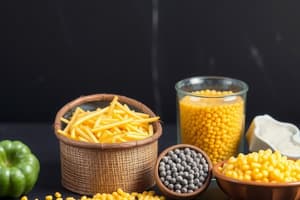Podcast
Questions and Answers
What does 'production' primarily refer to?
What does 'production' primarily refer to?
- The creation of goods and services (correct)
- The net profit from selling goods
- The distribution of resources
- The marketing of goods to consumers
Which of the following is NOT considered a factor of production?
Which of the following is NOT considered a factor of production?
- Labor
- Sales (correct)
- Land
- Management
What happens to consumer purchasing power when production costs rise?
What happens to consumer purchasing power when production costs rise?
- It decreases (correct)
- It remains the same
- It fluctuates unpredictably
- It increases
How are total costs of production calculated?
How are total costs of production calculated?
When total revenue (TR) exceeds total cost (TC), what is the suggested course of action?
When total revenue (TR) exceeds total cost (TC), what is the suggested course of action?
In the short run, if total revenue (TR) is less than variable costs (VC), what should a business do?
In the short run, if total revenue (TR) is less than variable costs (VC), what should a business do?
Which factor of production includes machines and buildings?
Which factor of production includes machines and buildings?
Which of the following is a characteristic of fixed costs?
Which of the following is a characteristic of fixed costs?
Match the following factors of production with their descriptions:
Match the following factors of production with their descriptions:
Match the following types of costs with their characteristics:
Match the following types of costs with their characteristics:
Match the following inputs with their potential outputs:
Match the following inputs with their potential outputs:
Match the following conditions to actions regarding production:
Match the following conditions to actions regarding production:
Match the following criteria for selecting suppliers with their corresponding qualities:
Match the following criteria for selecting suppliers with their corresponding qualities:
Match the following definitions with their respective terms:
Match the following definitions with their respective terms:
Match the following types of costs with their examples:
Match the following types of costs with their examples:
Match the following terms with their corresponding effects on consumer behavior:
Match the following terms with their corresponding effects on consumer behavior:
Flashcards
Factors of Production
Factors of Production
Resources used to create goods and services.
Land (Factor of Production)
Land (Factor of Production)
Natural resources like forests, water, and minerals.
Labor (Factor of Production)
Labor (Factor of Production)
Physical and mental effort of workers.
Capital (Factor of Production)
Capital (Factor of Production)
Signup and view all the flashcards
Entrepreneur (Factor of Production)
Entrepreneur (Factor of Production)
Signup and view all the flashcards
Fixed Cost
Fixed Cost
Signup and view all the flashcards
Variable Cost
Variable Cost
Signup and view all the flashcards
Profit Maximization
Profit Maximization
Signup and view all the flashcards
Production
Production
Signup and view all the flashcards
Utility
Utility
Signup and view all the flashcards
Inputs
Inputs
Signup and view all the flashcards
Outputs
Outputs
Signup and view all the flashcards
Total Cost of Production
Total Cost of Production
Signup and view all the flashcards
Study Notes
Production Aspect/Technical Aspect
- Production is the creation of goods and services, converting resources into satisfaction.
- Factors of production include land (natural resources), labor (physical & mental effort), capital (machinery, buildings), and entrepreneurial ability.
- Land includes natural resources like forests, mountains, rivers, and lakes.
- Labor encompasses all workers, from farmers to doctors.
- Capital refers to machinery, equipment, and buildings used in production.
- Entrepreneurial ability coordinates other factors to create efficient production.
Input-Output Relationship
- Inputs are resources needed for production (e.g., money, machines, materials, manpower, management, technology, information).
- Outputs are the goods or services produced (e.g., shoes, bags, books, houses, cars, rice).
Cost of Production
- Costs of production represent payments made to factors (land, labor, capital).
- Higher production costs lead to higher prices, reducing consumer purchasing power and potentially decreasing sales.
Total Costs of Production
- Total costs encompass all expenses in production, including fixed and variable costs.
- Fixed costs remain constant, regardless of production volume (e.g., rent).
- Variable costs change with production output (e.g., raw materials, salaries).
Rules of Production (Long-Run Period)
- Produce more when total revenue (TR) exceeds total cost (TC).
- Stop producing when total revenue is less than total cost.
- Maintain production when total revenue equals total cost.
Rules of Production (Short-Run Period)
- Operate when total revenue exceeds variable cost.
- Shut down when total revenue is less than variable cost.
Factors Essential for Production
- Good Suppliers:
- Must satisfy needed quality.
- Meet required quantity.
- Supply should be readily available.
- Products must meet necessary specifications for production.
Inventories
- Inventories are stocks of goods and materials. Different inventory types exist:
- Raw Materials Inventory: Stockpiles of resources for production.
- Work-in-Process Inventory: Partially finished products.
- Finished Goods Inventory: Products ready for sale.
Scheduling
- Scheduling is essential for delivering materials at the correct place and time for production.
Quality Control
- Quality control ensures goods and services meet design and specifications.
Productivity
- Productivity is the efficient creation of goods and services.
Studying That Suits You
Use AI to generate personalized quizzes and flashcards to suit your learning preferences.




